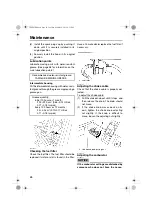
Operation
50
Do not follow directly behind watercraft
or other boats. Do not go near others to
spray or splash them with water, go too
close to other boats, or go too fast for
the traffic conditions. Avoid sharp turns
or other maneuvers that make it hard for
others to avoid you or understand where
you are going. Avoid areas with sub-
merged objects or shallow water.
Take early action to avoid collisions. Re-
member, watercraft and other boats do
not have brakes. Do not release the
throttle lever when trying to steer away
from objects—as with other power-
boats, you need throttle to steer.
WARNING
EWJ00634
Avoid forceful jet thrust and limited visibil-
ity while reboarding. Get to a standing or
kneeling position quickly. This will im-
prove visibility and limit exposure to jet
thrust.
NOTICE
ECJ01341
Never run the engine in water that is less
than 60 cm (2 ft) deep from the bottom of
the watercraft, otherwise pebbles or sand
could be sucked into the jet intake, caus-
ing impeller damage and engine overheat-
ing.
The watercraft is less stable when at a stand-
still or at a slow speed. It takes skill to keep
the watercraft upright when starting.
To stabilize the watercraft when accelerating
to planing speed, maintain a low center of
gravity by operating it in the kneeling posi-
tion.
Even though it is easier to start in shallow wa-
ter, you must learn deep-water boarding first.
You will inevitably fall off, so be sure you
know how to get back on the watercraft once
you are away from shore.
EJU33105
Boarding and starting in shallow water
Be sure to learn the deep-water starting
method before operating the watercraft in
water where it is too deep for you to stand.
(See page 51 for the deep-water starting
method.)
(1) Launch the watercraft in water free from
weeds and debris and at least 60 cm (2
ft) deep from the bottom of the water-
craft.
NOTICE:
Never run the engine in
water that is less than 60 cm (2 ft)
deep from the bottom of the water-
craft, otherwise pebbles or sand could
be sucked into the jet intake, causing
impeller damage and engine over-
heating.
[ECJ00473]
(2) Attach the engine shut-off cord (lanyard)
to your left wrist, and then attach the clip
to the engine shut-off switch.
UF4D15E0.book Page 50 Tuesday, March 19, 2019 4:31 PM
















































